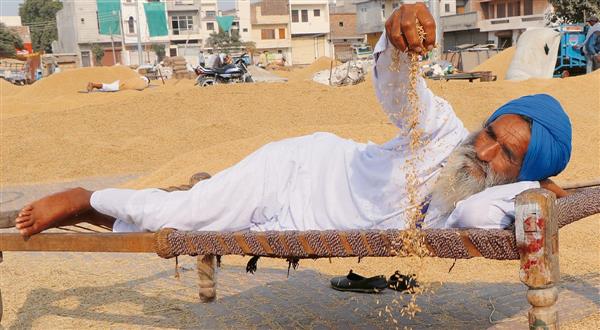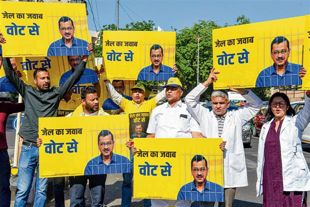
Alarming: Despite over 90 per cent of the farmers being dependent on markets all these years, Indian agriculture is still in the throes of a terrible agrarian distress.
Devinder Sharma
Food & Agriculture specialist
Reiterating what former US Agriculture Secretary Earl Butz (during Ronald Reagan’s rule) had declared: “Get big or get out,” Sonny Perdue, US President Donald Trump’s Agriculture Secretary recently said: “In America, the big get bigger and the small go out. I don’t think in America, (as) for any small business, we have a guaranteed income or guaranteed profitability.”
Wherever agriculture is being opened to markets, the big capital has successfully managed to push out the majority farming population and concentrated its control over food. That’s how the markets behave, with its own set of logic and ethics. As the big get bigger, the small farms struggle to survive. In America, after decades of market reforms in agriculture, only 1.5 per cent of its population has somehow managed to survive on the farm. Despite providing for $867 billion support under the Farm Bill 2018 over the next 10 years for agriculture, nutrition and conservation programmes, rising suicide rate, worrying trends of depression in rural areas, declining milk and farm commodity prices, and the mounting bankruptcy in farming — estimated at $425 billion — will make it tough for the family farms to survive the transition.
With the suicide rate being 45 per cent higher in rural areas as compared to urban America, low prices and mounting debt has pushed much of the rural population in the grip of stress and depression. What happened in America is no exception. It has in fact become an international agricultural design, with agribusiness gaining strongholds over the food value chains across the globe, in reality their competitive strength depending on the huge subsidies received. In Europe, farming too is in a severe crisis despite an annual subsidy support of $100 billion, of which nearly half goes as direct income support. Low prices and mounting debt has gradually pushed small farmers out of business. In the UK, 3,000 dairy farms have closed down in the past four years. In France, a study had shown that nearly 500 farmers commit suicide on an average in a year.
In India, 3.64 lakh farmers have officially committed suicide in the past 25 years as per the National Crime Records Bureau statistics. Despite 94 per cent farmers being dependent on markets all these years (as per the Shanta Kumar committee report), Indian agriculture is still in the throes of a terrible agrarian distress. Interestingly, an NSSO report in 2014-15 had shown that nearly 54 to 84 per cent farmers (depending on crops) in the kharif marketing season had sold their produce outside the mandis to private traders. In other words, farmers had the freedom to sell anywhere. They were not in the clutches of the mandis. The question therefore that needs to be asked is if markets were so efficient, why should farmers be increasingly abandoning agriculture and migrating to the cities. If markets were so benevolent, there is no reason why agriculture shouldn’t have been the engine of economic growth.
But this is how markets operate, pushing people away from agriculture primarily to provide cheap workforce for the industry. The big get bigger in the process and the small go out. For India, the Washington-based International Food Policy Research Institute (IFPRI) has a similar proposition — ‘move up or move out’. For several decades, mainline economists in India had been arguing on similar lines. Numerous committees and reports had pointed to the need to move towards market-friendly agriculture. Minimum Support Price (MSP) was named the culprit, coming in the way of real price discovery. In one form or the other, the emphasis had been on dismantling the vast network of Agricultural Produce Market Committee (APMC)-regulated mandis in Punjab and Haryana.
To strengthen the argument, even the Commission for Agricultural Costs and Prices (CACP) had come out with a table ranking states in terms of market-friendliness. Bihar topped the chart, and Punjab was at the bottom.
Punjab brings up the rear because 87 per cent of wheat and rice (as per CACP) is procured by the Food Corporation of India (FCI) or by public sector agencies on its behalf at a guaranteed MSP. In Bihar, less than 1 per cent of the wheat harvest is procured. If this is market-friendliness, economists need to explain what is so good about it. In Punjab and Haryana, comprising the food bowl, farmers receive Rs 80,000 crore a year by way of price support. As far as I can remember, barring a few instances, farmers have not received a price higher than the MSP in open markets. Market prices have always remained lower than the MSP announced for wheat and paddy, the two crops that are being procured. Similarly, for the 23 crops for which MSP is announced every year, open market prices have generally been lower.
The real price discovery for farmers is by MSP only. The need therefore is to make MSP a legal right for farmers and ensure that no trading takes place below the MSP, not only for wheat and paddy but for all the 23 crops for which MSP is announced.
Although the government says MSP and APMC markets will remain intact under the new marketing reforms being ushered in, farmers fear that APMC mandis will gradually become redundant. With APMC markets heading towards a collapse, the new set of reforms is aimed at encouraging corporatisation of agriculture, with big business moving into agriculture, storage and marketing. As the experience of US/Europe shows, when unregulated markets become dominant, small farmers are the first to be pushed out of agriculture. Given that 86 per cent farmers have less than five acres of land holdings, the message is clear: get big or get out.
Join Whatsapp Channel of The Tribune for latest updates.




























